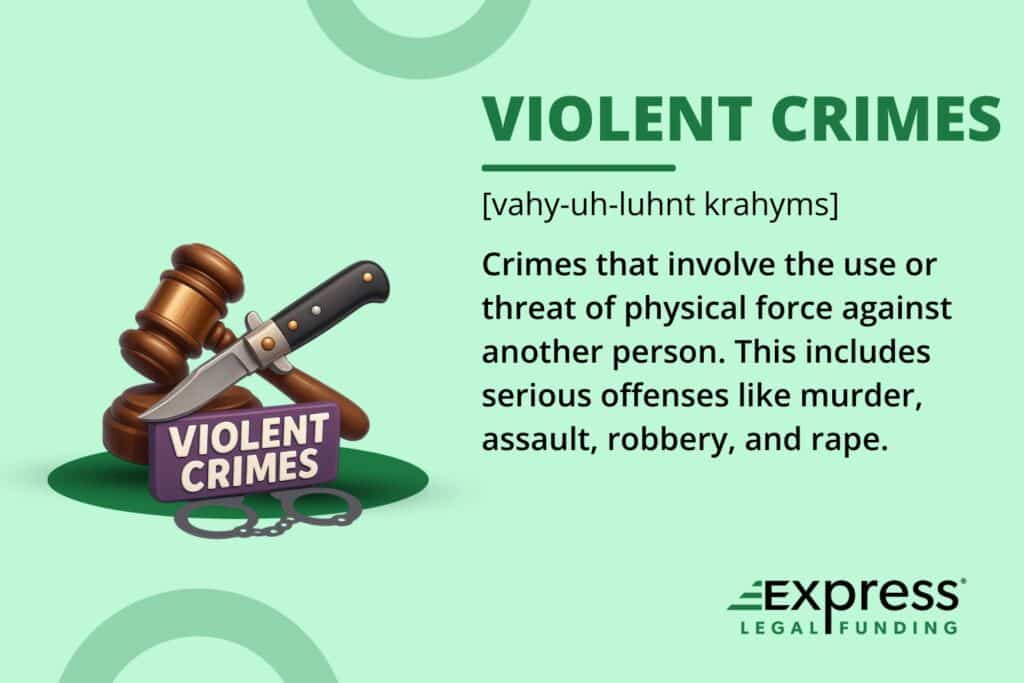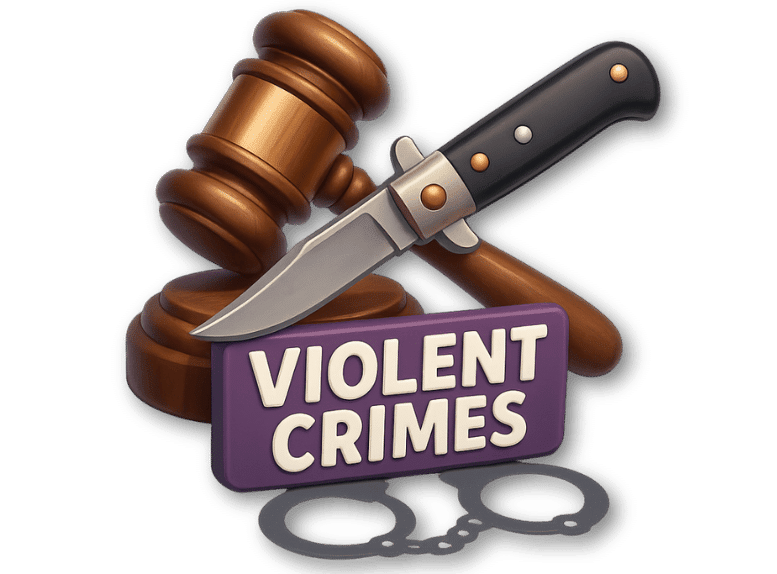Violent crimes are some of the most serious offenses under U.S. criminal law. They involve the use of physical force or the threat of force against another person.
Unlike property crimes, which involve damage to or theft of physical belongings, violent crimes pose a direct threat to a person’s body, safety, and life. These offenses often lead to significant physical harm, emotional trauma, and—in the most severe cases—death.
Due to the danger they pose to individuals and communities, violent crimes are aggressively prosecuted. Most are categorized as felonies, which carry heavier penalties than misdemeanors.
Sentencing can include long-term imprisonment, life sentences, or even the death penalty, depending on the nature of the crime, the state’s laws, and aggravating circumstances (such as repeat offenses or use of weapons).

What Is a Violent Crime?
A violent crime is a serious offense where a person uses, or threatens to use, physical force against another individual. These crimes put a victim’s safety or life at risk and often cause injury, fear, or death. Common examples include murder, rape, robbery, aggravated assault, sexual assault, and kidnapping. Violent crimes are typically prosecuted as felonies and carry the harshest penalties in the U.S. justice system.
FBI Definition of Violent Crime
In the United States, violent crimes are formally defined by the Federal Bureau of Investigation (FBI) through its Uniform Crime Reporting (UCR) Program, a nationwide system that compiles data from thousands of law enforcement agencies. According to the FBI, a violent crime is an offense in which the offender uses, or threatens to use, force against a victim.
The FBI tracks four core violent crimes under the UCR Program:
- Murder and Nonnegligent Manslaughter: The willful (nonnegligent) killing of one human being by another. This excludes deaths caused by negligence, accidents, or suicide.
- Rape (formerly called Forcible Rape): The penetration, no matter how slight, of the vagina or anus with any body part or object, or oral penetration by a sex organ of another person, without the consent of the victim. This definition, updated in 2013, is broader than the older “forcible rape” category and includes attempts.
- Robbery: The taking or attempting to take anything of value from the care, custody, or control of a person by force, threat of force, or by putting the victim in fear.
- Aggravated Assault: An unlawful attack by one person upon another for the purpose of inflicting severe or aggravated bodily injury, often involving a weapon or other means capable of causing serious harm.
These four crimes are classified by the FBI as Part I Violent Crimes, a subset of the broader Index Crimes that also include major property offenses like burglary, larceny-theft, and motor vehicle theft. The violent crime categories serve as a standardized benchmark for measuring crime trends across the country.
Additional Violent Crimes Not Tracked by UCR
The FBI’s (UCR) Program tracks only four core violent crimes: murder and nonnegligent manslaughter, rape, robbery, and aggravated assault—for national crime statistics. However, many state and local laws also classify additional offenses as violent crimes, even though they are not included in UCR data. Examples include:
- Kidnapping or abduction
- Domestic violence (not separately tracked, though underlying assaults or homicides are counted under UCR)
- Child abuse
- Elder abuse
- Terrorist threats or criminal intimidation
- Stalking, when it includes credible threats of violence
Because these offenses fall outside the FBI’s statistical definition, their treatment as violent crimes depends on state statutes, case circumstances, and the relationship between the victim and the offender.
5 Common Types of Violent Crimes
Violent crimes involve force or threats of force against another person. Below are five of the most commonly prosecuted violent crimes in the United States:
1. Homicide
Homicide refers to the unlawful killing of another person. States classify homicide differently, but the most common categories include:
- First-Degree Murder: Premeditated and intentional killing with malice aforethought. Often carries life imprisonment or, in some states, the death penalty
- Second-Degree Murder: Intentional killing without premeditation, often showing extreme disregard for human life.
- Voluntary Manslaughter: Killing committed in the “heat of passion,” usually following sudden provocation.
- Involuntary Manslaughter / Criminally Negligent Homicide: Unintentional killing caused by reckless or negligent conduct, such as a DUI-related death.
2. Robbery
Robbery is taking property directly from another person through violence, intimidation, or threats.
- Armed Robbery: Involves the use of a weapon to instill fear or cause injury.
- Strong-Arm Robbery: Relies on physical force or intimidation without a weapon.
Robbery is more serious than theft because it involves direct confrontation and personal danger, even if no one is physically harmed.
3. Aggravated Assault
Aggravated assault is an attack intended to cause serious bodily injury. It often involves a deadly weapon or results in severe harm.
- Examples: Stabbing, hitting someone with a blunt object, choking or strangling, or using a vehicle to cause injury.
- Enhanced Penalties: Sentences may increase when the victim is a child, elderly person, or law enforcement officer.
4. Sexual Assault
Sexual assault refers to non-consensual sexual acts or contact. While terms vary by state, most laws cover a wide range of behavior:
- Rape and Attempted Rape: Non-consensual penetration, including attempts.
- Sexual Battery: Unwanted sexual touching or groping.
- Coercion or Exploitation: Acts committed when the victim cannot give consent due to age, disability, unconsciousness, or fear.
Sexual assault is harshly prosecuted, often leading to lengthy prison terms and mandatory sex offender registration.
5. Kidnapping
Kidnapping is the unlawful taking, confinement, or movement of a person against their will through force, threat, or deception.
- Aggravating Factors: Use of weapons, targeting of children, or transporting victims across state lines (which may trigger federal jurisdiction).
- Parental Kidnapping: Occurs when one parent unlawfully takes a child in violation of custody orders. While still serious, it is usually prosecuted differently from forcible abduction.
What Is the Difference Between Violent and Non-Violent Crimes?
The main difference between violent and non-violent crimes is whether physical force or the threat of force is used against another person.
- Violent Crimes: Involve direct harm or the threat of harm to a person’s body, safety, or life. Examples include assault, robbery, murder, rape, and kidnapping. These crimes often cause physical injury, fear, or even death.
- Non-Violent Crimes: Do not involve physical harm to another person. Instead, they typically affect property, money, or public order. Examples include fraud, embezzlement, insider trading, bribery, and most drug possession offenses.
How Do Courts Treat Violent vs. Non-Violent Crimes?
Violent crimes are usually punished much more severely than non-violent ones because they threaten or harm a person’s safety. Penalties often include longer prison sentences, higher bail amounts, mandatory minimums, and fewer parole opportunities.
By contrast, non-violent crimes—such as fraud, embezzlement, or drug possession—are more likely to result in fines, probation, restitution, or shorter jail terms. Courts often emphasize rehabilitation and repayment rather than maximum incarceration.
Public perception is also stricter toward violent offenses, which can influence jury decisions, prosecutorial discretion, and sentencing outcomes.
Legal Consequences of Violent Crimes
Violent crimes carry some of the harshest penalties in the U.S. criminal justice system. These punishments are intended to reflect the serious physical and emotional harm inflicted on victims while also deterring future offenses and protecting the public.
- Incarceration: Sentences for violent crimes range from several years to life in prison. In states with capital punishment, certain offenses such as first-degree murder may be punishable by death.
- Fines and Restitution: Courts often impose financial penalties. Offenders may be required to pay fines to the state and restitution directly to victims for medical expenses, lost wages, or emotional harm.
- Probation and Parole: In some cases, offenders may serve part of their sentence under community supervision. Strict conditions apply, and violations can result in reincarceration.
- Mandatory Programs: Judges may order offenders to attend anger management, substance abuse treatment, or mental health counseling, especially when these issues contributed to the crime.
- Loss of Civil Rights: A felony conviction for a violent crime can strip individuals of rights such as voting, firearm ownership, and eligibility for certain jobs or professional licenses.
Repeat violent offenders frequently face enhanced penalties under “three strikes” laws or habitual offender statutes. These laws are designed to impose harsher sentences—sometimes life imprisonment—for individuals considered an ongoing threat to public safety.
Real-World Examples of Violent Crimes
Violent crimes occur in many different settings and affect people from all walks of life. Below are violent crime examples that illustrate how these serious offenses can happen and how the justice system typically responds:
- Armed Robbery: A masked individual enters a gas station, brandishes a firearm, and demands cash from the clerk. No shots are fired, but the use of a weapon and threat of harm classify the act as a violent felony crime. Convictions can lead to lengthy prison sentences.
- Domestic Violence: An individual repeatedly strikes their partner during heated arguments at home. The victim suffers both physical injuries and emotional trauma. Once reported, the case may result in criminal assault charges, protective orders, and mandatory counseling for the offender.
- Sexual Assault on Campus: A student forces another into a non-consensual sexual act after a party. The crime is investigated by both university officials and local police, often leading to criminal prosecution, expulsion, and mandatory sex offender registration if convicted.
- Homicide During a Dispute: A verbal altercation between neighbors escalates until one fatally stabs the other. The attacker is arrested and charged with second-degree murder, facing potential life imprisonment depending on state law and aggravating factors.
These examples highlight that violent crimes can happen in private homes, public places, schools, or among acquaintances. The legal classification depends not only on the location but also on the actions, intent, and harm caused during the incident.
Is Burglary a Violent Crime?
No, burglary is generally classified as a property crime, not a violent crime. Burglary involves unlawfully entering a building or structure with the intent to commit theft or another felony inside. Since it targets property rather than people, the FBI and most states treat burglary as non-violent by default.
However, burglary can become a violent crime if it involves force or threats against a person. For example, if a homeowner is confronted and assaulted during a break-in, the act may also be charged as robbery or aggravated assault, both of which are violent crimes.
Is Domestic Violence Always Considered a Violent Crime?
Yes. Domestic violence is treated as a violent crime because it involves force, threats, or abuse against a partner, family member, or household member.
Domestic violence, also known as intimate partner violence, is not a separate category in the FBI’s UCR system, but at the state level, the underlying acts—such as assault, battery, sexual assault, or homicide—are almost always prosecuted as violent offenses when they occur in a domestic setting.
Why Violent Crime Data Matters
Tracking violent crime data helps communities make informed decisions about safety, justice, and public health. Reliable statistics allow law enforcement to identify high-risk areas and allocate officers and resources more effectively.
- Policy Development: Legislators use violent crime data to guide public policy, such as sentencing reform or victim support services.
- Community Safety: Neighborhood watch programs, local policing strategies, and grant funding are often shaped by local crime statistics.
For legal funding providers, violent crime data helps assess the environment in which a plaintiff’s case arose. If a personal injury case involves assault in a high-crime area, that may influence funding risk levels and case evaluation timelines.
Reporting and Tracking Violent Crimes
Violent crimes are tracked and reported by multiple government agencies. Accurate and consistent crime data is essential for criminal justice reform, law enforcement planning, and public accountability.
- Uniform Crime Reporting (UCR): A national program managed by the FBI that collects standardized crime data from over 18,000 agencies. It focuses on index crimes, including four main violent offenses: murder, rape, robbery, and aggravated assault.
- National Incident-Based Reporting System (NIBRS): Offers more detailed reporting than UCR, capturing specific circumstances, victim-offender relationships, and the presence of weapons.
- Local and State Law Enforcement Data: Cities and counties often publish their own crime dashboards or annual public safety reports, though definitions and reporting methods can vary.
Data collection challenges include underreporting, inconsistent definitions between jurisdictions, and delays in law enforcement submissions. Still, these tracking systems play a crucial role in identifying trends, advocating for resources, and promoting transparency in policing.

